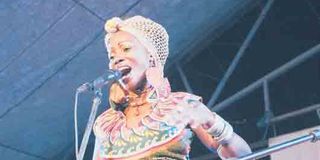Energetic gig from Zawose to Sali Oyugi

What you need to know:
The traditional music of Africa, given the vastness of the continent, is historically ancient, rich and diverse having many distinct musical traditions.
Dar es Salaam. Traditional African music is a gem! That is a fact! Rarely seen in the main stream media yet they holds the foundation on which today’s music is built especially in a country with so much diversity as Tanzania. The traditional music of Africa, given the vastness of the continent, is historically ancient, rich and diverse having many distinct musical traditions.
The music and dance of the African diaspora, formed to varying degrees on African musical traditions, include American music and many Caribbean genres, such as soca, calypso and zouk.
Latin American music genres such as the rumba, conga, bomba, cumbia, salsa and samba were also founded on the music of enslaved Africans, and have in turn influenced African popular music.
Last weekend in Dar es Salaam renowned traditional music group the Zawose Family which is famous for their performance and conservation of the Gogo music reminded revellers what they have been missing.
There were many famous faces here including veteran performer John Kitime who on this day played the role of an announcer.
Playing at the Nafasi Art Space for the monthly gig which has become of the hottest dates on the entertainment calendar, the group took the audience through a cultural experience.
The group kicked off the proceedings of their three set act with a display of authority in playing the Zeze which left patrons clapping and whistling.
This was followed by the thumb piano which is a common instrument amongst the Gogo people in central Tanzania.
But as the first two sets were male dominated they had perhaps reserved the best for the last with a set of female drummers who were nothing but a sensation.
Their choreography was breathtaking as the energetic dancing left the stage vibrating.
Following up on the Zawose performance was Sali Oyugi whose illustrious CV sometimes seems like a burden at certain points. This was the first time she was performing in Tanzania despite being a frequent visitor especially to Tanga where her mother hails from.
“This was my first performance in Tanzania, I was so honoured to come and share what I do with my creativity,” she said.
It was an energetic performance as she took the audience through a musical journey that traces to over decade. “I loved it, the audience was awesome, they received me very well the energy that they displayed pushed me all the way and I know I will be coming back very soon,” she said.
Chegelese is one of the songs that she performed on this night and it really got the audience worked up as they got into the ‘Mduara’ formation, a dance that is quite popular in the Coastal areas.
She says the last album Uromo has opened doors for her as the more opportunities continue coming through due to the success of her album.
But even with the success in secular music Sali says gospel music is still part of her and it is not a burden in any way trying to make the two sides work.
I don’t think it is two, I happen to be a spiritual and very creative person. I am spiritual; I love to create things that people can relate to. I know that there are times when people love to put you in those boxes but for me music is still just music,” she says.
Even with such a performance that has become a feature of the Zawose Family, Sali Oyugi and many others that take place at Nafasi Art Space, the audience as usual was suspect.
Those who were in attendance were mainly tourists who seemed to have a night worth the bother.
This was a free performance which had been funded by some donors with the purpose of exploring Tanzanian and African music, yet the very people who are supposed to value the music could not see that. This is where we fail and the status-quo is likely to stay that way for a very long time to come.
What many consider as a gem is eluding the very people that are supposed to be preserving its existence.
To date it is still baffling as to what has to be done for traditional music to attract local audiences.




